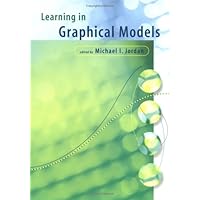
Average Reviews:

(More customer reviews)The title of the book is somewhat misleading, in that most of the research papers involve advanced issues concerning one particular graphical model, namely the Bayesian network. For this reason I highly recommend, as a prerequisite to this book, Finn Jensen's "Bayesian Networks and Decision Graphs". Jensen's book is adequate in giving a good introduction and overview of the subject, but not sufficient for calling oneself an "expert" upon successfully digesting it.
To its credit, "Learning in Graphical Models" has several well-written and interesting papers, but the tutorial papers just did not seem enough of an introduction for me to feel comfortable using it as a first source of introduction.
What I find most compelling about Bayesian networks is the fact that they seem both highly modular (which facilitates reusability and network interconnectivity) and can be designed in a semi-rational manner (contrast this with neural-network architectures for which few good algorithms exist for determining size and number of layers). For this reason I imagine they will be important players in future engineering projects that require learning and adaptation.
Click Here to see more reviews about: Learning in Graphical Models (Adaptive Computation and Machine Learning)
Graphical models, a marriage between probability theory and graph theory,provide a natural tool for dealing with two problems that occur throughout appliedmathematics and engineering--uncertainty and complexity. In particular, they play anincreasingly important role in the design and analysis of machine learningalgorithms. Fundamental to the idea of a graphical model is the notion ofmodularity: a complex system is built by combining simpler parts. Probability theoryserves as the glue whereby the parts are combined, ensuring that the system as awhole is consistent and providing ways to interface models to data. Graph theoryprovides both an intuitively appealing interface by which humans can model highlyinteracting sets of variables and a data structure that lends itself naturally tothe design of efficient general-purpose algorithms.This book presents an in-depthexploration of issues related to learning within the graphical model formalism. Fourchapters are tutorial chapters--Robert Cowell on Inference for Bayesian Networks,David MacKay on Monte Carlo Methods, Michael I. Jordan et al. on VariationalMethods, and David Heckerman on Learning with Bayesian Networks. The remainingchapters cover a wide range of topics of current research interest.

No comments:
Post a Comment